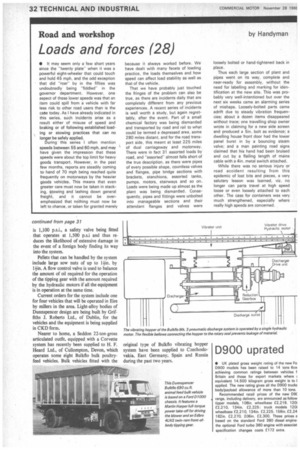Road and workshop by Handyman
Page 34

If you've noticed an error in this article please click here to report it so we can fix it.
Loads and forces (28)
• It may seem only a few short years since the "twenty plate" when it was a powerful eight-wheeler that could touch and hold 45 mph, and the odd exception that did "roar" by in the fifties was undoubtedly being "fiddled" in the governor department. However, one aspect of these lower speeds was that an item could spill from a vehicle with far less risk to other road users than is the case today. As I have already indicated in this series, such incidents arise as a result either of misuse of speed and braking or of following established loading or stowing practices that can no longer be safely applied.
During this series I often mention speeds between 55 and 60 mph, and may have given the impression that these speeds were about the top limit for heavy goods transport. However, in the past few months, reports are steadily coming to hand of 70 mph being reached quite frequently on motorways by the heavier goods vehicles. This means that even greater care must now be taken in stacking, stowing and lashing down general freight, and it cannot be overemphasized that nothing must now be left to chance, or taken for granted merely because it always worked before. We have dealt with many facets of loading practice, the loads themselves and how speed can affect load stability as well as that of the vehicle.
That we have probably just touched the fringes of the problem can also be true, as there are incidents daily that are completely different from any previous experiences. A recent series of incidents is well worth a study, but again regrettably, after the event. Part of a small chemical factory was being dismantled and transported by road and rail to what could be termed a depressed area, some 280 miles distant, and for the road transport side, this meant at least 225 miles of dual carriageway and motorway. There were in fact 31 assorted loads by road, and "assorted" almost falls short of the true description, as there were pipes of every possible shape, countless valves and flanges, pipe bridge sections with brackets, stanchions, assorted tanks, pumps, motors, stairways and so on. Loads were being made up almost as the plant was being dismantled. Consequently, pipes and fittings were unbolted into manageable sections and their attendant flanges and valves were
loosely bolted or hand-tightened back in place.
Thus each large section of plant and pipes went on its way, complete and near-ready for assembly, without the need for labelling and marking for identification at the new site. This was probably very well-intentioned but over the next six weeks came an alarming series of mishaps. Loosely-bolted parts came adrift due to steady vibration frequencies; about a dozen items disappeared without trace; one travelling shop owner wrote in claiming for a new side screen and produced a 5in. bolt as evidence: a dwelling house front door had the lower panel burst in by a bouncing steam valve; and a man painting road signs claimed that his hand had been bruised and cut by a flailing length of mains cable with a 4in, metal switch attached.
While there was no serious injury or road accident resulting from this epidemic of lost bits and pieces, a very salutary lesson was learned, viz, no longer can parts travel at high speed loose or even loosely attached to each other. The case for containers was very much strengthened, especially where really high speeds are concerned.
















































































































